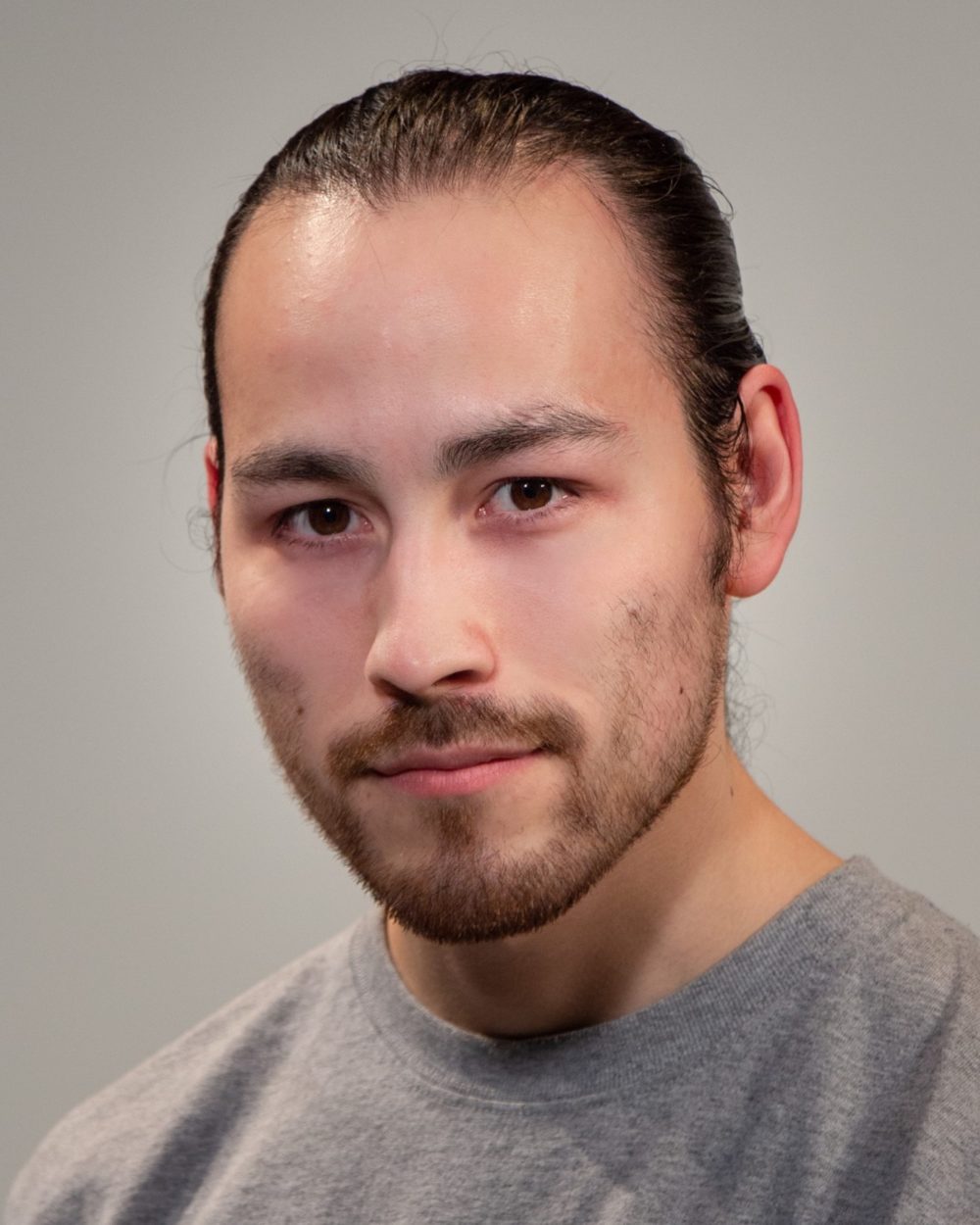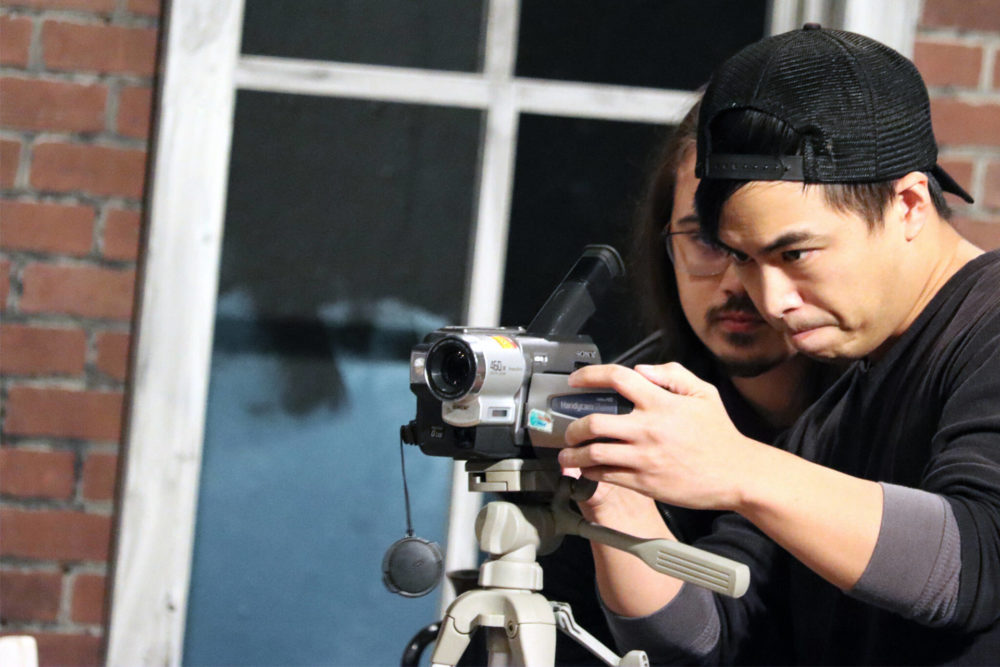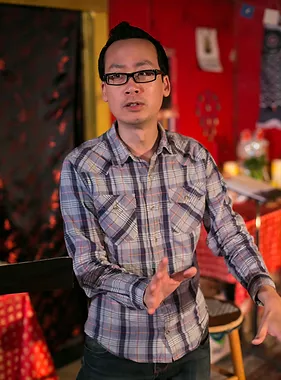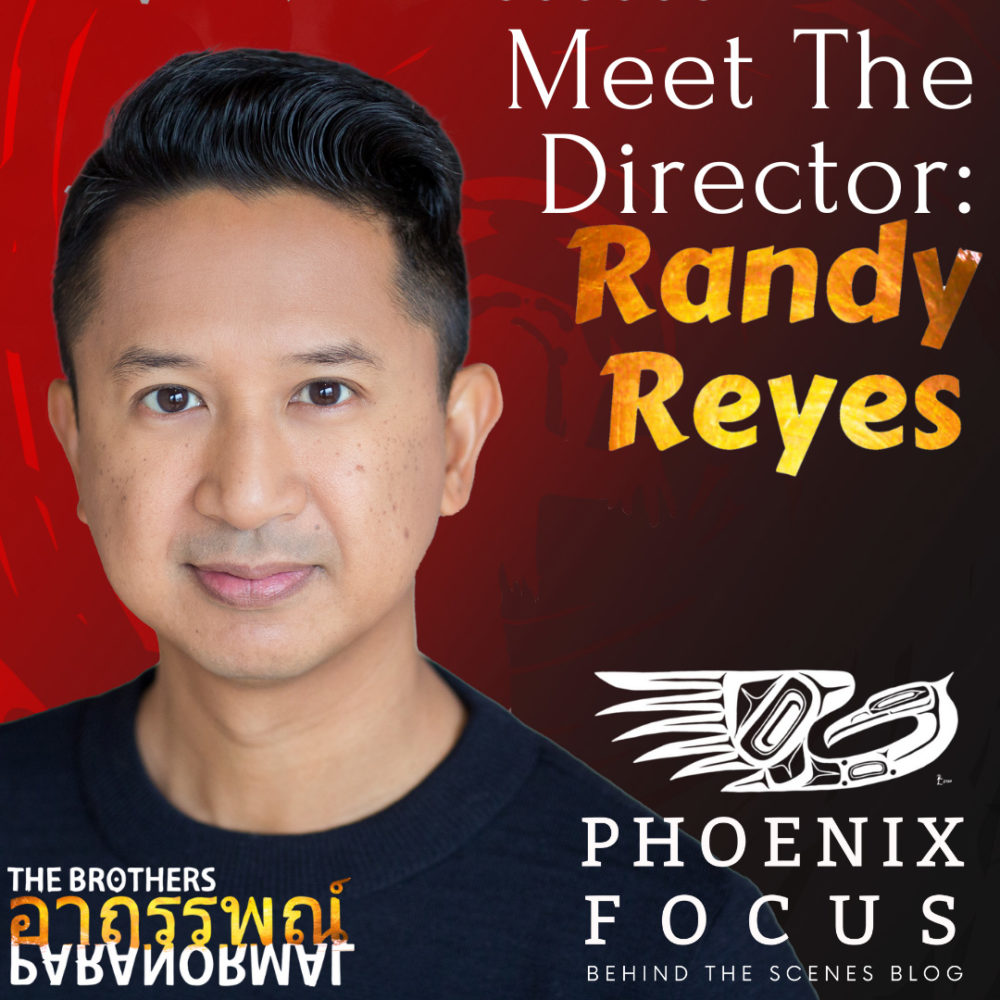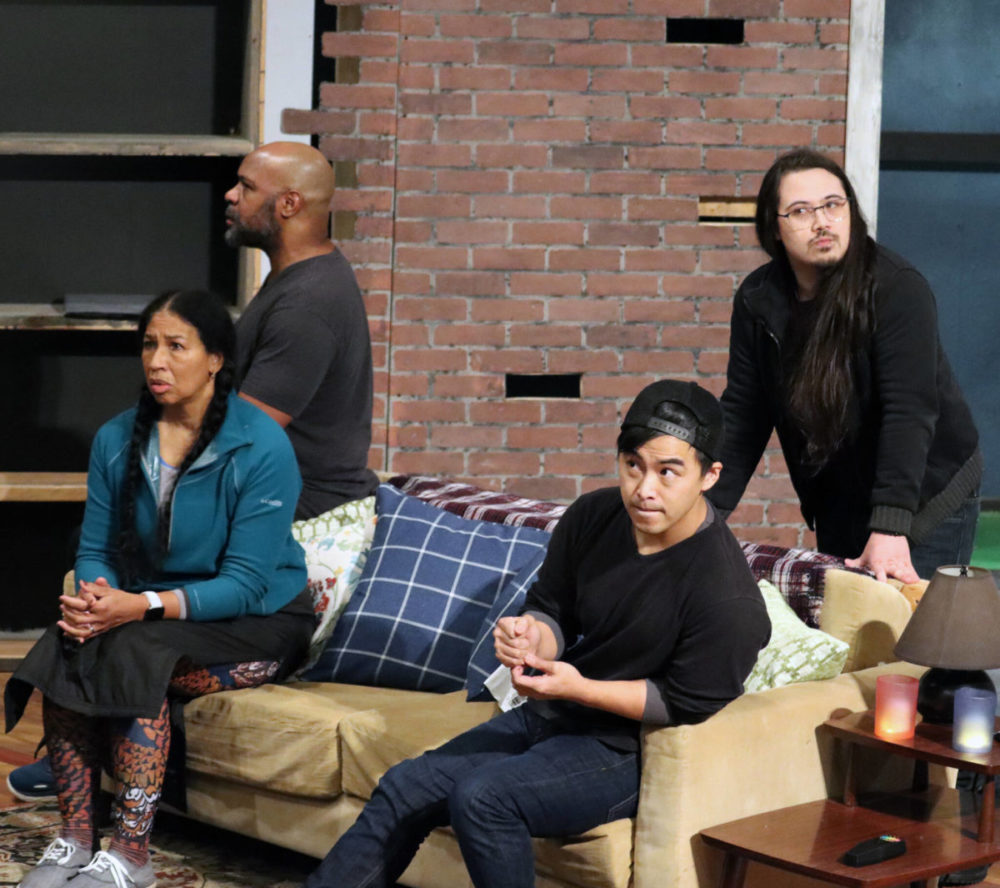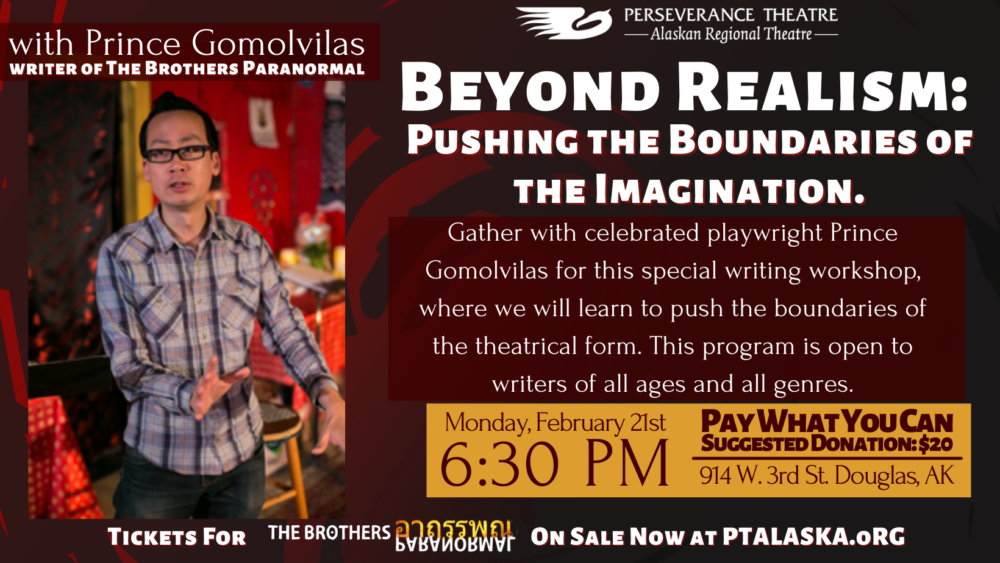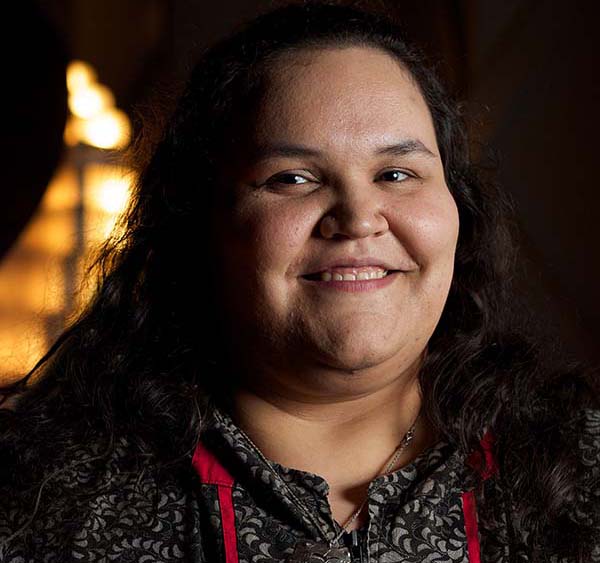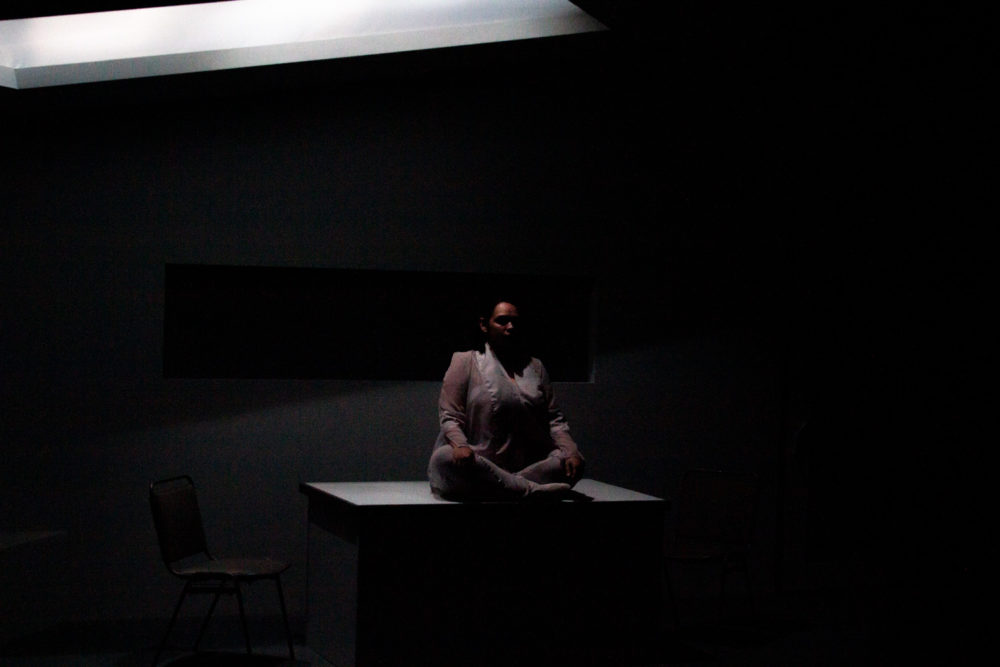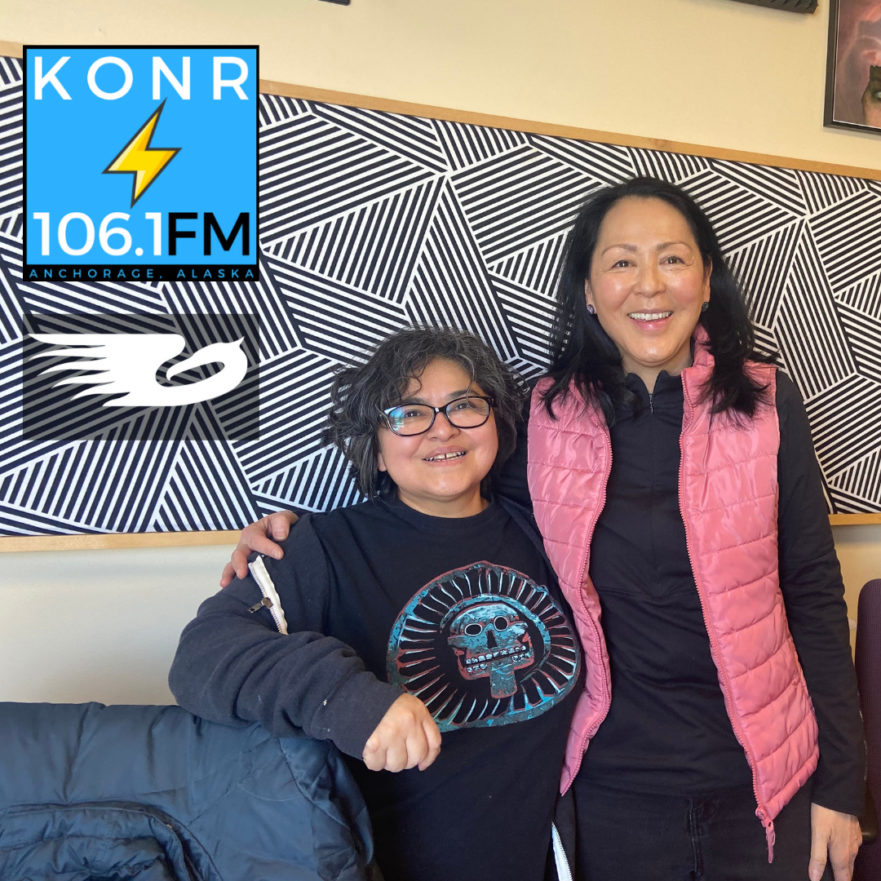

Acting Through the Pandemic
My name is Jared Olin. I am Tl’eeyegge Hʉt’aane, and I’ve come to Perseverance Theatre (PT) as this year’s Artistic Apprentice. When asked about what I’d like to focus on throughout the year, I responded with acting, directing, and writing. I’ve come to work on and learn so much about all three of these focus areas, but acting was my first significant assignment from the theatre in my role as Carl/Ceygan in Jared Michael Delaney’s Voyager One. It’s been so exciting to step back onto the stage of an in-person theatre again, but COVID has certainly made the past couple of years a challenge.
The entire world has been tilted by the weight of COVID-19, and theatre has certainly not been exempt from that in these past two years. My experience under this pressure may sound very familiar to other performers in this industry. To share my personal path down this road, we have to go back to the beginning.
Bang….
Oh, sorry. Not that far back.
So it’s March 2020, and I’m in our final rehearsals of Pride and Prejudice for the University of Alaska Fairbanks’ (UAF) production where I’m playing Mr. Bingley/Mary Bennet. Things are ramping up with our dance choreography, the technical team is prepping to fine-tune the show, and we’re just about set to present it to the world. The next thing we know, quarantine comes in like a wrecking ball and we’re forced to cancel the show. After such hard work and so many hours, this unexpected cancellation hit pretty hard… It’s something that COVID took away from our whole team, because we never got the chance to present the show as originally intended.
A year later, we were finally able to present the show, but it took a different form. Our version of Pride and Prejudice was converted into a virtual production with some significant changes. The largest hurdle to get over as an actor was to realize that I couldn’t rely so much on physical movements for comedy or other emotional beats like I would in a regular theatrical production. Our acting had to be condensed into the frame of our laptop cameras, and our performances transformed to be more understated as we utilized film acting techniques. It did allow for some of the more intimate moments to shine brighter, but it was very hard not to yearn for the beautiful orchestration that was present in the original performance. Still, it was lovely to see how our team persevered by returning to this show and finishing it.
The first show I worked on during the pandemic was She Kills Monsters: Virtual Realms with UAF, in which I played Miles. This was in November of 2020, and was my introduction to creating virtual theatre. This is where I’d learn about just how many technical things could go wrong in a virtual production. There were a lot of technical factors to keep track of before our takes, so it turned out that the actors had to also become camera operators by-proxy. We all got the hang of it by the end, but there were plenty of mistakes made before we got to that point.
Titus Andronicus was my next theatrical venture with PT in February 2021, and was my first experience of a live virtual reading. I enjoyed the live format because it felt a little closer to in-person theatre shows. Performing this show live also left us open to hosting a Q&A afterwards which allowed for great discussions of the piece.
Also in February of 2021, I performed in a radio play performance of As You Like It with Fairbanks Shakespeare Theatre (FST). This too, was a welcome change of form as I was able to perform with just my voice. For this production, I was faced with a challenge I never expected. My neighbors. They were just walking around upstairs, but it sure sounded like stomping to the sensitive microphone and I. Waiting for the moments in between their walking around was enough to fix that disruption.
The next show I worked on was The Winter Bear in May 2021, a play based on a part of my great grandfather’s life. This was a virtual production as well, and remains close to my heart, as this was my first time acting in a show where the entire cast was Alaska Native or Native American. The new element added to this show, at least to me, was the use of a green screen. It suggested the idea that the actors were actually outside in the cold or in the old cabin settings within the play. While I haven’t worked with a green screen in the past, it was very easy to get used to. I’d pick a point in my apartment to look at (as if I was looking at the other actor), and perform the scene to that focal point. A con to that, was the fact that I couldn’t look at my acting partner during those scenes, which sometimes helps with reactions, but I adjusted quickly to the new circumstance. I’m very happy with all the work that we put in for this show.
August 2021 was when I made it back on the main stage with FST’s production of Twelfth Night. Still in the midst of rising and falling cases, we had to continue precariously. We kept up with UAF’s COVID action plans and were sure to adjust our plans for seating audience members when the show opened. They don’t have locked-in-place chairs, so we were able to physically distance multiple sections of the seating area by placing the chairs further apart. Our nerves about the pandemic had been building for a year and half at this point, but a slight alleviation to that stress was the fact that we held this performance in an outdoor playing space.
This is where Voyager One comes in. Back in November 2021, I was able to perform in Perseverance’s production, and I’m proud of how it turned out. That was also in large part because of how safe it felt. PT had many safety precautions to keep us and visitors safe. At the door, we were met with a COVID safety officer to check our temperature and ask us if we felt any related symptoms. Once we passed that check, we could step into the Voyager One rehearsal room as long as we kept our masks on the entire time. It made the whole process feel very safe, and as we progressed further into production, we also shifted our safety calls. During the performance, there was a 1-foot square where we couldn’t step or risk being within 10 feet of an audience member without our mask on. To work around that, we literally did just that. We blocked our movements around that square and made sure not to step there during the run. These are little things that built up to make the atmosphere of performing for Perseverance Theatre feel as safe as possible.
Acting has been a tricky thing to maintain through the pandemic, with in-person theatres shutting down left and right. It seems that the world is building confidence to open these venues back up, but I believe that virtual theatre work will continue. While I am excited to keep journeying back into physical theatre spaces, I am also very prepared to keep looking for roles in more radio and virtual productions. This is especially true if it means that I can keep my family and other families in the community safe. Enaa baasee’. (Thank you very much.)
Meet the Director: A Conversation with Randy Reyes
Q: Tell us a little bit about yourself, and what you’re doing here in Juneau.
A: Hello, my name is Randy Reyes. I am the director of The Brothers Paranormal and this is my first time in Alaska, from Minneapolis, MN!
Q: How did you first become involved with Perseverance Theatre?
A: Well, Leslie Ishii brought me to Perseverance Theatre. Leslie has been a colleague of mine for a long time. We started working together as part of the Consortium of Asian American Theaters & Artists. I was part of putting together the production in the Twin Cities, a co-production between Penumbra Theatre and Theatre Mu, directed by Lou Bellamy. This was another opportunity to do the play. And Leslie was in that production, so when she asked if I wanted to direct this production, I asked her if she wanted to be in this one as well, and she said yes. So I’m just very excited that she’s going to be in the show and that she invited me to direct it here in Alaska, in Juneau, which is a gorgeous beautiful place that I’m totally in love with.
Q: Prior to the shutdown, when were you last able to be in a theatre?
A: Since the shutdown, I’ve done theatre projects. One was a theatre dance project that was not fully produced. It wasn’t a play, so this is the first play in a theatre that I’ve done since the shutdown. And the other was a play set in a zoo.
Because of the new surge, we started this rehearsal process via Zoom. Yeah, it’s very emotional actually. It’s great to be back. It’s great to be back in a theatre, great to be back in the process of creating, in putting up a play. I’m ready. I’m too ready. I’m so excited that I’m beside myself!
Q: What does it mean to you to be returning to creating in the theatre?
A: When the lockdown happened, I was trying to figure out how to continue to do theatre, and a lot of the theatre that was being done was through Zoom. And in the midst of that, living in Minneapolis, where George Floyd was murdered, and that really made me question what I should be doing as an artist. What kind of stories should I be telling? What kind of communities should I be lifting up? So I went into a little identity crisis during that, and then started to write more and do some Zoom things. But that was not theatre to me, it’s video. It’s not a live audience so it wasn’t theatre. And I had to take time to mourn that. To mourn theatre not existing for a while. Having it come back means everything.
I’m very excited to be in the same room with actors. So many things happen in the room together, so many discoveries are made that are limited when you’re in a box, a zoom box. And then the audience, that’s another huge part of theatre is live audiences and how that affects the production. But I think I’m most excited to come back with a play like The Brothers Paranormal, a story of a Thai family and an African American couple. It’s a story about home. It’s a story about what haunts you, about trauma, about displacement, about climate change, and mental health… So to be with a cast as diverse as this, with a production team as diverse as we have, in a place, Perseverance, where Leslie’s really emphasizing a culture of equity and diversity, justice and inclusion. It is an honor, it is so exciting, it’s a great way to come back! I wouldn’t want to come back to do anything else. Like if I were to come back to do a regional theatre production of A Christmas Carol, it would be fine, but to come back to this, especially in this magical place, Juneau, AK, it’s a great honor.
Q: And we’re honored to have you. Talk to me about some of the themes that struck you in this story, The Brothers Paranormal.
A: The thing that struck me initially when I first read the play by Prince Gomolvilas was the genre of horror, right? I was like, “Oh my gosh! Who writes live theatre in the horror genre?! I love that! I love the idea of being able to scare someone in a live setting. That was my initial response. But the play is so much more than that.
And then you have the Thai family who are dealing with issues around immigration, displacement and mental health. You don’t see a Thai family represented in television, film, theatre in America, so that’s very exciting. And then you also have African American representation with the couple also dealing with displacement and mental health. So to have those two ethnic groups in the same play when you’re talking about the things that haunt you, and all the parallels between those two communities…it was the most unique play I’ve read in a long time and I am so committed to having this story told and to having people hear this story, not only the general public but especially from the Thai community and the Thai American community. To be able to see their story being told is very important.
Q: How can audiences expect to see these themes come forward in your work?
A: I did classical training as an actor at the University of Utah, and then went to Juilliard where I graduated in 1999 and throughout that whole time, I’d never been in a play where I played an Asian character. I’m Filipino American. So I had a really skewed idea of what kind of artist I was, and I thought I could do classical work. I didn’t know what I didn’t know, and I was naive in that way. But once I graduated from Juilliard, I had an agent, I was auditioning, and I realized I wasn’t getting the same opportunities that my white counterparts were getting, and it didn’t matter that I didn’t feel like I was limited by being Asian…everyone else did. So I really had an identity reckoning where I had to find a way to embrace who I was.
It wasn’t until I was cast in a workshop of Flower Drum Song that David Henry Hwang was doing, that I was part of an all Asian cast for the first time ever. And it was a different energy. It was a whole different game! I don’t know how to explain it other than saying there was a sense of family that I’d never had before. There was a sense of understanding, there were shortcuts… It was just an easier room, and how I fit in that room was also very different. And that’s not even a Filipino character. The first Filipino character I played was Magno in The Romance of Magno Rubio, and that changed my life. that was like, “Oh, this is my culture! I am an expert in this. I don’t even have to try. I don’t have to research. I just am. There’s language in it, there was movement, we did stick fighting, we sang in Tagalog… I was born in the Philippines so that changed everything. Suddenly I wasn’t acting, I was just being, and felt completely comfortable within that. And I realized that in other times, I was acting beside myself. I was acting apart.
I teach acting and I do this exercise where I have the students imagine their character. I remember doing this in a college, and I was having the students imagine their characters, what the character looks like, their hair, what they’re dressed as, look at their hands, all this, their eyes. And I’ve never said this before, but in the moment I said, “Ok, look at their ethnicity. What is their ethnicity?” And I realized in that moment that every character that I had ever played I had imagined as white, and I almost had a breakdown right there. I wasn’t using myself! I was not authentic to myself. I was acting like something rather than being. And from then on, my acting changed dramatically. I had to start from me. I was in A Christmas Carol and I had to figure out why I looked the way I did and why I was in A Christmas Carol. Any show, I had to start with the way that I look and justify that, find my backstory, and then I could move forward.
But that’s how that all started. So I think that’s why I’m so committed to this… We have three Thai Americans in this cast which is unbelievable, and I just want them to be able to bring themselves to the piece. To me it was life changing and totally changed me as an artist, to be able to play my own ethnicity or feel myself, feel comfortable to just use myself. And I know there’s a lot of actors that never even have to think of that. It’s just assumed. So yeah, I understand that journey, and I’m excited to share that journey with this cast.
Q: And we’re excited as well, thank you. Okay – now some lighter questions: what is your favorite scary movie?
A: I think my all time favorite scary movie is Pet Semetary and I don’t know why. I think that animals and kids who haunt people, freak me out. I used to watch The Twilight Zone and yeah, I’ve always been freaked out by when kids and animals come back to life, more than adults for some reason! And then The Ring really freaked me out. But I feel like where I was in my life when I saw Pet Semetary, it scared me in a profound way. Yeah what’s the one with Jack Nicholson? Yes, The Shining, because that was more psychological, and I think that if you ask me what really scares me, it’s how dark the human psyche can get. And that freaks me out more than gore. To see how dark a human can get, especially to their own family…that’s horrifying.
Q: Which is scarer to you? Ghosts or vampires?
A: Ghosts.
Q: Ghosts or aliens?
A: Ghosts.
Q: Ghosts or zombies?
A: Ghosts.
Q: Ghosts or psycho killers?
A: Psycho killers.
To learn more about Perseverance Theatre’s production of The Brothers Paranormal and to purchase tickets, visit ptalaska.org/tbp.
Playwriting Class – Beyond Realism: Pushing the Boundaries of the Imagination
Playwriting Class Description
Beyond Realism: Pushing the Boundaries of the Imagination. Nineteenth century writer
Charles Baudelaire once condemned realism as a “war on the imagination.” While that idea can
seem amusingly hyperbolic today, it can also serve as a healthy challenge to writers interested in stretching their creativity, breaking the rules, and taking risks. In this lecture/workshop, we will
study contemporary examples of plays that push the boundaries of the theatrical form. With film
and television hewing so closely to the rigid parameters of realism, theatre remains a place where writers are able to experiment with wild abandon, while still telling stories that are grounded in recognizable human struggles and emotions. Since the skills learned here will be of benefit in other writing forms as well, this program is open to writers working in all genres.
WHERE: In-Person at Perseverance Theatre, 914 3rd St. Douglas AK
WHEN: Monday, February 21st @ 6:30PM
COST: Pay What You Can – Suggested Donation of $20
Instructor Bio
Prince Gomolvilas is a Thai-American writer and winner of a PEN Center USA Literary Award
for Drama. His critically acclaimed play, The Brothers Paranormal, debuted Off-Broadway at
the Beckett Theatre, in a production by Pan Asian Repertory Theatre. It has since been published
by Dramatic Publishing, performed across the country, and scheduled for productions in Juneau,
Anchorage, and Los Angeles. He is the co-creator of a new TV series currently in development
at Amazon Studios, and he is a former Assistant Professor of Writing at the University of
Southern California. More info can be found at https://www.princegomolvilas.com/.
Meet the Playwright: A Conversation with Vera Starbard Pt. 2
With the holiday season behind us, you may be wondering, “How can I continue to enjoy Vera Starbard’s incredible work now that A Tlingit Christmas Carol has passed?” Trust me, we’ve all been there.
But fear not! With a seemingly unending list of exciting projects stacked up on her to-do list, there is no shortage of Vera Starbard writing to enjoy. How lucky are we?!
I recently had the pleasure of sitting down with Vera (over Zoom) and discussing her upcoming projects and the process of writing for theatre, television, and even opera. Yes, I said opera. Vera Starbard truly does it all.
For instance, A Tlingit Christmas Carol isn’t Vera’s only adaptation in the works. Her play Native Pride (and Prejudice) is also a modern Indigenous take on a classic. This hilarious retelling of Jane Austen’s famous story is narrated by Raven themself, and dives into the use of blood quantum laws in the United States. Vera masterfully brings this story into modern Alaska, and as you watch the play unfold, you genuinely find yourself forgetting that Jane Austen’s novel didn’t include dance regalia and Alaskan salmon. And of course, she never forgets the humor.
“I think Pride and Prejudice is often taken as this serious love story, but when you read the book, it’s very funny. It’s very snarky humor, and that gets lost in a lot of adaptations,” Vera shared. “It can be very serious because they’ve taken out the author’s voice. I like bringing in the author to sort of commentate and say what we’re all thinking. I like breaking that fourth wall and bringing the audience into the joke.”
Having read the play myself, I can absolutely confirm that it will make you laugh. And in addition to the comedy, there’s a reason Vera keeps coming back to adaptations.
“I love these books,” Vera explained. “Any adaptation I’ve considered is a book I loved growing up, including A Christmas Carol, including Pride and Prejudice. At the same time, these are all books that were published in a time when Native work was just not being published. There was nobody like me in these publications. Nobody that looked like me or talked like me. I still loved them, because they spoke to me in different ways. For as much as they influenced my childhood, I do look back and see how devoid of Native influence my reading was.”
As a writer, Vera has been able to use her work to tell stories from that Native perspective that she was missing as a child. And in doing so, she’s making sure that when Indigenous children go to the theatre or turn on their televisions, they are able to see themselves represented. For instance, as a writer for the popular PBS Kids show Molly of Denali, Vera has seen the impact that her work has had firsthand.
“Growing up I could tell you a dozen shows that meant a lot to me that I ran to every time they were on. There were animated movies that I watched over and over again,” she explained. “But I’ve never ever once seen anyone that looked like me or talked like me or did anything really all that similar to what I did! And that says something to a kid about how much they’re valued and how much they matter. The sort of big unsaid message is that you don’t matter enough to be represented on TV.”
Set in the fictional Alaskan village of Qyah, the show follows Molly, an Alaska Native vlogger, as she spends time with her friends, family, and dog, and helps out in her family’s store, Denali Trading Post. Vera recalls two moments that impacted her when she watched the pilot of the show for the first time. One was a moment in which Molly’s mom casually beaded an Athabascan design while talking to Molly, and the second was seeing the character Mr. Patak in a sealskin vest.
“I’ve never seen anything remotely like a sealskin vest in an animated show, but it’s such a common thing to see in my culture,” said Vera. “Those two scenes made me so emotional, and to see them put up on PBS of all places… it said, ‘Yeah, you matter and what you look like and what you act like and the daily little boring things you do matter.’ And I think of the whole generation of Alaska Native kids that will get to grow up seeing Molly and they’ll never know a world where they aren’t represented. They’ll never know a world in which they don’t matter in this way.”
And the beautiful thing is that Vera often hears from her audience when they express to her just how much the show means to them.
“I get messages about the last episode that I had out called ‘Molly and Elizabeth,’” continued Vera. “Molly is approached by two white people who don’t think she looks Native enough. This is a really common experience… You don’t look Native enough and you don’t act Native enough. After that episode came out, I got all of these messages from parents that said that they’d already seen their kids being approached with that and tagged with that. And their kids are watching this show and feeling encouraged that they can say, ‘That’s not okay’. There’s a lot of those kinds of moments throughout the series, whether I wrote the episode or not, that make me so proud to be Native, and I love that kids get to watch that and be proud of who they are.”
As she creates this wonderful work and collaborates on project after project, you may wonder how she has time for anything else. In fact, I’ve asked her on multiple occasions when she has time for sleep (Her answer is often: I don’t!). But somehow, Vera is also a part of the writing team behind the first ever Tlingit opera, an exciting project produced by Sealaska Heritage Institute and Perseverance Theatre. Set during the Tlingit-Russian War in Alaska during the early 1800s, Vera and composer Ed Littlefield have partnered to tell stories based on historical fact and oral traditions from the Tlingit perspective.
“In some ways it’s the easiest writing and in some ways it’s the hardest writing I’ve ever done,” explained Vera. “Ultimately, the whole play will be in Tlingit, so I’m working with Tlingit linguists to translate everything that I’m writing. And that makes it pretty hard because then you’re discussing every word as, ‘Is that what you really mean? Is that what you’re intending?’ So in that way it’s the hardest, because it’s sort of not my words. More of my work will be seen in the stage directions and in how the story plays out which are all things that aren’t being said.”
“The easy part is opera dialogue is really short,” she continued. “There’s a lot of repetition and you can take two minutes to say one sentence. In fact, there’s very little that I need to write in comparison to anything else that I’ve written. And the challenge again is… Does that work with the music? Does that work with the rest of the story? Is that going to work in translation? I’m literally not going to know if my story is working until we’re into rehearsals and we can see that people will understand the story through a combination of lyrics, music, story, set. It feels like extreme theatre!”
As I’m sure you can tell, there are opportunities to enjoy Vera’s work right now, and even more opportunities coming up in the future. Whether you turn on PBS Kids to catch an episode of Molly of Denali or you join us at the theatre to see a Vera Starbard play, you can enjoy her beautiful storytelling, her clever humor, and the Indigenous stories that she so thoughtfully shares.
Meet the Playwright: A Conversation with Vera Starbard Pt. 1
‘Tis the season! For evergreen trees and cookie decorating and singing? Sure! For gifts and colorful lights and snowmen? Absolutely! But most importantly, ‘tis the season for your holiday theatre favorite.
That’s right! This year, the multi-part virtual production of A Tlingit Christmas Carol by Vera Starbard is back at Perseverance Theatre, and we couldn’t be more excited. To celebrate the return of this beautiful and hilarious show, I sat down for a Zoom session with Tlingit and Dena’ina playwright Vera Starbard to talk about her work in theatre, opera, television, and more.
Vera Starbard is not only Perseverance Theatre’s Playwright-in-Residence, but is also an accomplished writer across many genres, platforms, and styles. She serves as Editor of First Alaskans Magazine, writes for the Peabody Award-winning PBS show Molly of Denali, and has won numerous awards including the Rasmuson Foundation Individual Artist Award and Alaska Literary Award. And although she wasn’t able to tell me any details, she did (cryptically) mention projects with Netflix and Disney, so keep an eye on your streaming platforms!
Yes, she’s one of the busiest people I know. But how did she become a writer in the first place? Why was she drawn to storytelling and how did her plays end up onstage?
“I have always known I was going to be a writer since I was in kindergarten. That was never a question,” Starbard said when I asked her about her writing journey. “When I was 14, the freshmen weren’t allowed to join the high school newspaper, but my English teacher made an exception. And I had such a big head about it! Like ‘Wow my writing is amazing, genius, I’m going to be published by 15!’”
But when she turned in her first article to the newspaper’s editor, it was handed back to her covered in a sea of red.
“It was stomach dropping! I’d never had anything I’d ever written marked up like that,” continued Vera. “But that’s part of what got me hooked, too. This could be better and someone knows how to make it better and they can show me how!”
Writing for the school newspaper put Vera on the path of journalism. She enjoyed the pressure and the challenge of it, and saw firsthand the kind of power that writing can have. Some of her pieces even resulted in real changes in school policy!
Fast forward past high school graduation and Starbard held writing and editing jobs from age 18 on. She was always doing some form of writing professionally, and she still made sure she could work on creative writing in her spare time, primarily crafting short stories until 2009. That was when she was awarded the Rasmuson Foundation Individual Artist Award.
This financial support allowed her to take a full month off to travel and finish her novel Devilfish Sleeps. Does that sound familiar? If you saw Perseverance Theatre’s production of Devilfish back in 2019, then it should ring some bells… Yes, that was another Vera Starbard original!
But when she finished her novel and took a step back to look at it, she realized that she wasn’t as excited about her dialogue as she hoped to be, and wanted the opportunity to improve it. This led her to the Alaska Native Playwrights Project, a program seeking established Alaska Native writers in order to teach them how to write play scripts.
“I really took that as an exercise in how to write dialogue,” Vera explained. “That would be it. I would write this one play as an exercise and never write another script ever.”
Famous last words! She spent that first year, under the mentorship of acclaimed playwright Larissa FastHorse, writing Our Voices Will Be Heard, and though she wasn’t immediately hooked on playwriting, it was the first workshop for this piece that gave her the theatre bug.
“It was seeing what the director and the actors did with it. That’s what got me hooked!” Starbard emphasized. “They took what I wrote and made it so much better and that’s what put me onto that kind of collaboration.”
It was from there that Vera found her way to Perseverance Theatre.
“Perseverance was the first theatre to produce my play, and I don’t know if I would have a playwriting career if they hadn’t wanted to,” said Starbard. “For 25 years I had a pretty good idea of what I was going to do, and sort of formed my life around that, and I think it was really good for me to get knocked off that track and show me that there’s this whole other arena that I can go into. And some of that was I did not see Alaska Native women writing plays or writing television shows and there’s just no model for that. I did have Alaska Native books. There were very few of them, but that part I could hold and see and feel and look at. But I’d never imagined a TV career because there was no one that looked like me or spoke like me on television.”
And this brings me to the wonderful and innovative work that Vera has done in telling Alaska Native stories onstage, onscreen, and on paper. For instance, A Tlingit Christmas Carol takes this “classic” story and brings it to modern Southeast Alaska.
“I’ve always loved the story of A Christmas Carol,” Vera said when I asked her about why she chose to adapt this piece. “The point of an adaptation from someone of a different gender and different culture is to see it from a different perspective. My focus was on Scrooge and how he was not sharing his wealth.”
Vera then taught me that this focus emerged from the strong Tlingit value of sharing your wealth. In Tlingit culture, there is no such thing as private property. Rather, there’s clan property, and it’s something you share with the entire clan. If your clan and your family aren’t doing well then you’re not doing well, and you need to make sure everyone’s clothed and fed and taken care of.
“That was a really strong message from my dad,” Vera explained. “He told me, ‘If you’re not doing well, then we’re not doing well.’ It’s not about who has the most wealth so much as making sure the resources are taking care of everyone. And that always struck me with the story. Scrooge was hoarding this thing that belonged to the community, and the fact that at the end, he starts giving it to the community… that was the point to me.”
And her sense of community and these strong Tlingit values ring true when you watch the play for yourself. But what also sticks with you is the comedy.
“If you read the book, the original Dickens version, it’s hilarious! It’s a really funny story almost entirely because of the author’s narration of events and commentary,” said Vera. “Funnily enough, the adaptations that carry the spirit of the Dickens version the most are things like Mickey’s Christmas Carol and The Muppet Christmas Carol. Those are the ones that find that voice again and find the funny in it. I really wanted to find the funny in the story, and a lot of that comes in the form of the Spirit of Christmas Present.”
A Tlingit Christmas Carol is a virtual play in five parts, or staves, and borrows that form from the original Dickens text. It is also filled with “Tlingit-ized” versions of Christmas carols crafted by Starbard and Alaska Native composer and performer Ed Littfield. Trust me, it’s a lot of fun to sing along!
And yes, this is a virtual production. When the pandemic hit and suddenly we found ourselves in turmoil, the theatre world was hit especially hard.
“I, like many theatre people, watched six months worth of scheduling just disappear over the course of three days, and this was our answer to both having something at Perseverance, and also having something for actors and directors and musicians while everyone was out of work,” Vera reflected. “And just a gift to the community! We wanted to give people some laughs and Christmas songs while a majority of the world couldn’t be together.”
To enjoy A Tlingit Christmas Carol, visit ptalaska.org/atcc now through January 8, 2022. You can find an album of the “Tlingit-ized” Christmas carols at https://tlingitchristmascarol.bandcamp.com/releases and companion coloring books created by Vera and her father Don Starbard are available for purchase using the link below.
Sigóowu Kíswas!
The Golden Record: A Journey Through Space and Time
On September 5, 1977, NASA launched the Voyager 1 space probe out of our atmosphere and into the cosmos.
Fast forward 44 years to 2021. This is when I read Jared Michael Delaney’s sci-fi play Voyager One for the very first time, and I’ll admit, I had absolutely no idea what the Voyager 1 space probe even was. Or I should say, what it is.
Because yes, Voyager 1 is both very real and it’s still out there, journeying through interstellar space and collecting data on its path. And on Voyager 1, rests the Golden Record, shining in its case, ready to be deciphered by extraterrestrial life.
Add this to the list of things I wish I’d learned about in school!
Having now taken a dive into the real story behind the play, I’m absolutely fascinated by this piece of human history and, of course, regularly overwhelmed by the vastness of the universe and my little place in it. But existential crisis aside, let’s talk more about Voyager 1 and the Golden Record.
Voyager 1 was designed specifically to conduct research on planets within our solar system and beyond, into interstellar space, regularly communicating findings back to Earth so that we as a species could learn more about what’s out there. But NASA saw the potential in this mission for something even more special, and perhaps a little more unconventional.
Thus emerged the Golden Record. And yes, it is a literal record plated in gold. It contains music, “Sounds of Earth”, greetings in 55 different languages, and a series of images all designed to depict human life on Earth to any alien being who might come across it. The cover of the record is etched with pictures in an attempt to convey how a record should be played, and it was even sent with a cartridge and a needle. They really were trying to make extraterrestrial communication a little easier!
It is, in essence, a veritable time capsule of humanity, capturing the hopes, the desires, the realities, and even the priorities of the United States in 1977. And now, it is the farthest man-made object from our very own planet… a little piece of the 1970s floating through interstellar space.
What’s more, the people behind the Golden Record certainly left their mark on its contents. For instance, famous scientist Carl Sagan was put in charge of the NASA committee that set out to determine what would actually make it onto the record. You can now hear his laughter, captured in etchings and floating through space, as one of the “Sounds of Earth”. And his son, who was six years old at the time, recorded one of the English greetings, telling alien listeners, “Hello from the children of planet Earth”.
Even romantic love made it onto the Golden Record. Ann Druyan, Creative Director of the project, had the brilliant idea of recording her own brain waves to be included on Voyager 1. She thought about many topics, including Earth’s history, civilizations and the problems they face, and what it was like to fall in love. And the beautiful thing? She was actually falling in love with Carl Sagan at the time. They married not long after and remained happily together for the rest of Sagan’s life. What could be more human than falling in love and wanting to tell the entire universe all about it?
Listening to the contents of the record on the internet using my modern-day laptop, I’m left with a feeling of curiosity and optimism, and that’s what I find so fascinating about this whole thing. There’s something so beautifully hopeful about the Golden Record.
Over a year was spent determining what would go on this metal disc, what would perfectly encapsulate this intended image of humanity, and yet there was never a guarantee that the Golden Record would ever be found. We don’t know if there is life outside of our planet, and even if we did, there is no way of knowing that they would find Voyager 1, that they would be able to play the record, or that they would even understand what they had found.
Yet, against all odds, NASA decided to move forward with this project anyway, because that unbelievably slim chance still made it all worth it.
If we were to make a version of the Golden Record today, I’m sure it would look pretty different. It likely wouldn’t be a record at all. After all, technology has changed quite a bit and continues to do so at a rapid pace. And I imagine there would still be a lot of debate about whether or not Johnny B. Goode should be the rock and roll song of choice.
But I like to believe that our hope remains the same. We may not know what the future holds, but we can look at where we are now and think about where we’re going. We can work on doing better with every moment that we exist on this planet and in this universe, and we can hope that what we put out into the vastness of space is something positive, and something that reflects who we are.
You can stream Voyager One by Jared Michael Delaney On Demand now through December 12. For more information, visit ptalaska.org.

